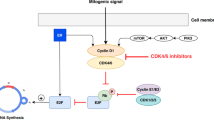Abstract
Purpose
Inhibitors of DNA (cytosine-5)-methyltransferases (DNMT) are active antineoplastic agents. We conducted the first-in-human phase I trial of 5-fluoro-2′-deoxycytidine (FdCyd), a DNMT inhibitor stable in aqueous solution, in patients with advanced solid tumors. Objectives were to establish the safety, maximum tolerated dose (MTD), pharmacokinetics, and pharmacodynamics of FdCyd + tetrahydrouridine (THU).
Methods
FdCyd + THU were administered by 3 h IV infusion on days 1–5 every 3 weeks, or days 1–5 and 8–12 every 4 weeks. FdCyd was administered IV with a fixed 350 mg/m2/day dose of THU to inhibit deamination of FdCyd. Pharmacokinetics of FdCyd, downstream metabolites and THU were assessed by LC–MS/MS. RBC γ-globin expression was evaluated as a pharmacodynamics biomarker.
Results
Patients were enrolled on the 3-week schedule at doses up to 80 mg/m2/day without dose-limiting toxicity (DLT) prior to transitioning to the 4-week schedule, which resulted in an MTD of 134 mg/m2/day; one of six patients had a first-cycle DLT (grade 3 colitis). FdCyd ≥40 mg/m2/day produced peak plasma concentrations >1 µM. Although there was inter-patient variability, γ-globin mRNA increased during the first two treatment cycles. One refractory breast cancer patient experienced a partial response (PR) of >90 % decrease in tumor size, lasting over a year.
Conclusions
The MTD was established at 134 mg/m2 FdCyd + 350 mg/m2 THU days 1–5 and 8–12 every 4 weeks. Based on toxicities observed over multiple cycles, good plasma exposures, and the sustained PR observed at 67 mg/m2/day, the phase II dose for our ongoing multi-histology trial is 100 mg/m2/day FdCyd with 350 mg/m2/day THU.



Similar content being viewed by others
References
Lapeyre JN, Becker FF (1979) 5-Methylcytosine content of nuclear DNA during chemical hepatocarcinogenesis and in carcinomas which result. Biochem Biophys Res Commun 87(3):698–705
Baylin SB, Jones PA (2011) A decade of exploring the cancer epigenome—biological and translational implications. Nat Rev Cancer 11(10):726–734
Jones PA, Baylin SB (2002) The fundamental role of epigenetic events in cancer. Nat Rev Genet 3(6):415–428
Silverman LR, Demakos EP, Peterson BL, Kornblith AB, Holland JC, Odchimar-Reissig R, Stone RM, Nelson D, Powell BL, DeCastro CM, Ellerton J, Larson RA, Schiffer CA, Holland JF (2002) Randomized controlled trial of azacitidine in patients with the myelodysplastic syndrome: a study of the cancer and leukemia group B. J Clin Oncol Res 20(10):2429–2440
Kantarjian H, Issa JP, Rosenfeld CS, Bennett JM, Albitar M, DiPersio J, Klimek V, Slack J, de Castro C, Ravandi F, Helmer R 3rd, Shen L, Nimer SD, Leavitt R, Raza A, Saba H (2006) Decitabine improves patient outcomes in myelodysplastic syndromes: results of a phase III randomized study. Cancer 106(8):1794–1803
Quintas-Cardama A, Santos FP, Garcia-Manero G (2010) Therapy with azanucleosides for myelodysplastic syndromes. Nat Rev Clin Oncol 7(8):433–444
Smith SS, Kaplan BE, Sowers LC, Newman EM (1992) Mechanism of human methyl-directed DNA methyltransferase and the fidelity of cytosine methylation. Proc Natl Acad Sci USA 89(10):4744–4748
Jones PA, Taylor SM (1980) Cellular differentiation, cytidine analogs and DNA methylation. Cell 20(1):85–93
Kaysen J, Spriggs D, Kufe D (1986) Incorporation of 5-fluorodeoxycytidine and metabolites into nucleic acids of human MCF-7 breast carcinoma cells. Cancer Res 46(9):4534–4538
Kreis W, Watanabe KA, Fox JJ (1978) Structural requirements for the enzymatic deamination of cytosine nucleosides. Helv Chim Acta 61:1011–1016
Beumer JH, Eiseman JL, Parise RA, Joseph E, Holleran JL, Covey JM, Egorin MJ (2006) Pharmacokinetics, metabolism, and oral bioavailability of the DNA methyltransferase inhibitor 5-fluoro-2′-deoxycytidine in mice. Clin Cancer Res 12(24):7483–7491
Kreis W, Woodcock TM, Gordon CS, Krakoff IH (1977) Tetrahydrouridine: physiologic disposition and effect upon deamination of cytosine arabinoside in man. Cancer Treat Rep 61(7):1347–1353
Beumer JH, Parise RA, Newman EM, Doroshow JH, Synold TW, Lenz HJ, Egorin MJ (2008) Concentrations of the DNA methyltransferase inhibitor 5-fluoro-2′-deoxycytidine (FdCyd) and its cytotoxic metabolites in plasma of patients treated with FdCyd and tetrahydrouridine (THU). Cancer Chemother Pharmacol 62(2):363–368
Smith RD, Malley JD, Schechter AN (2000) Quantitative analysis of globin gene induction in single human erythroleukemic cells. Nucleic Acids Res 28(24):4998–5004
R Core Team (2014) A language and environment for statistical computing. R Foundation for Statistical Computing, Vienna. http://www.R-project.org
Pinheiro JC, Bates DM (2000) Mixed-effects models in S and S-plus. Springer, New York
Fathallah H, Atweh GF (2006) DNA hypomethylation therapy for hemoglobin disorders: molecular mechanisms and clinical applications. Blood Rev 20(4):227–234
Acknowledgments
A California Cancer Consortium Study. This manuscript is dedicated to the memory of Dr. Merrill J. Egorin, who would be a co-author if he were able to review the manuscript. Previous Presentation: Presented in part at the 38th Annual Meeting of the American Society of Clinical Oncology, May 18–May 21, 2002, Orlando, FL and the 102nd Annual Meeting of the American Association for Cancer Research, April 2–6, 2011 Orlando, FL. An interim pharmacokinetic analysis has been published [13]. Research Support: Supported in part by U01CA062505, UM1CA186717, P30CA033572, N01-CM-52202, U01CA099168, UM1CA186690, and P30CA047904.
Conflict of interest
None.
Ethical standard
The manuscript has not been submitted to more than one journal for simultaneous consideration. The manuscript has not been published previously (partly or in full), nor split up into several parts. No data have been fabricated or manipulated (including images). No data, text, or theories by others are presented as if they were the author’s own. Consent to submit has been received explicitly from all co-authors, as well as from the responsible authorities—tacitly or explicitly—at the institute/organization where the work has been carried out, before the work is submitted. Authors whose names appear on the submission have contributed sufficiently to the scientific work and therefore share collective responsibility and accountability for the results.
Author information
Authors and Affiliations
Corresponding author
Electronic supplementary material
Below is the link to the electronic supplementary material.
Rights and permissions
About this article
Cite this article
Newman, E.M., Morgan, R.J., Kummar, S. et al. A phase I, pharmacokinetic, and pharmacodynamic evaluation of the DNA methyltransferase inhibitor 5-fluoro-2′-deoxycytidine, administered with tetrahydrouridine. Cancer Chemother Pharmacol 75, 537–546 (2015). https://doi.org/10.1007/s00280-014-2674-7
Received:
Accepted:
Published:
Issue Date:
DOI: https://doi.org/10.1007/s00280-014-2674-7




